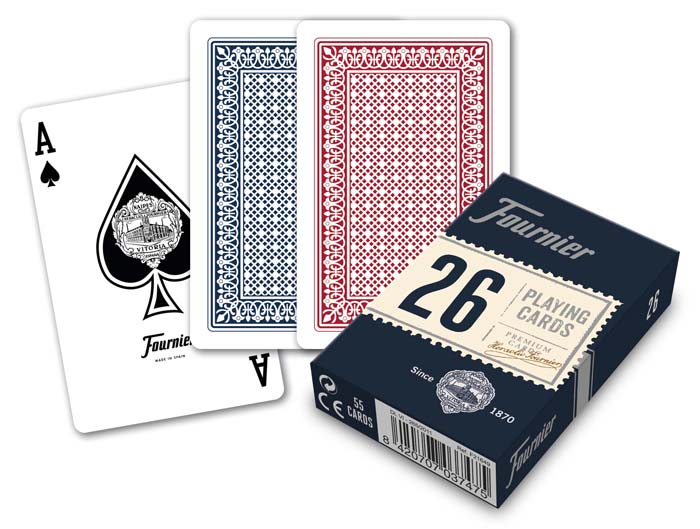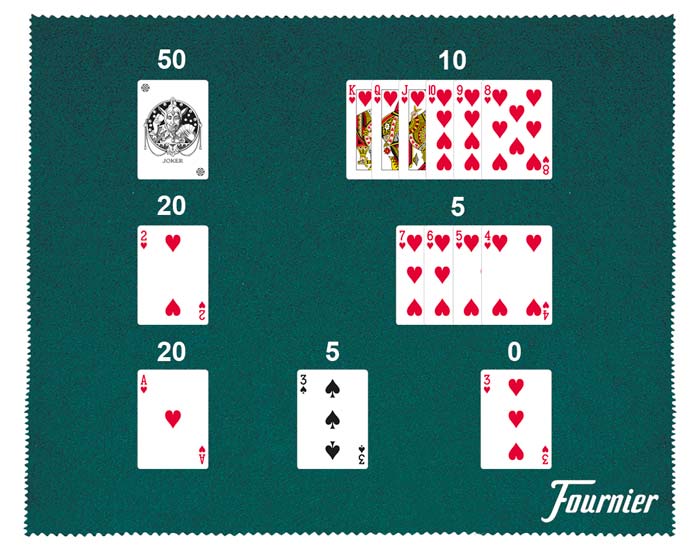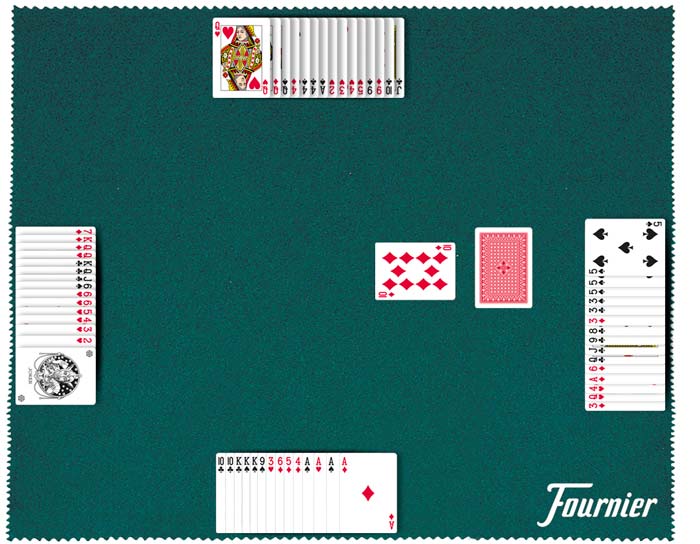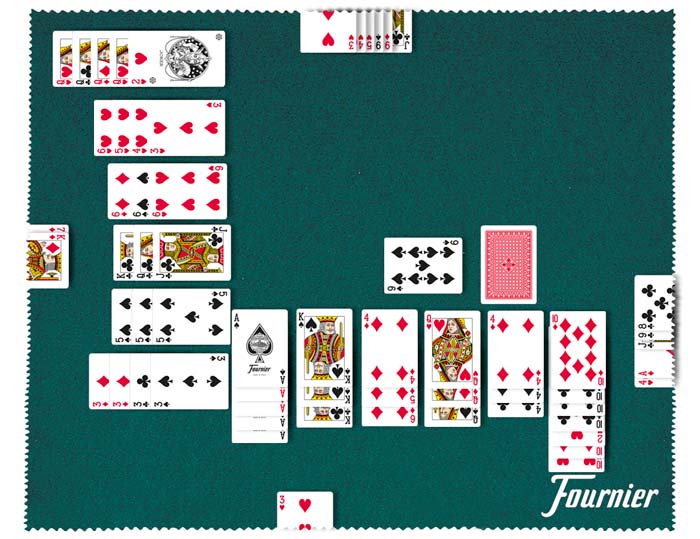Samba is a new version of Canasta that has quickly become very popular due to its variety of melds, which means that the game is always kept interesting.
Discarding the cards held by placing them face up on the table to meld a Canasta or Samba and, during several partial games, to reach the minimum 10,000 points required to win the game before your opponents do.
It is played using two 52 card English decks, plus the two wild cards or Jokers in each deck. In addition to the six wild cards, the twelve deuces have the same use.
It can be played by two to six players. The most interesting game is played by four players, forming pairs, which is the game that these rules explain.
For any of the four suits the value of the cards is as follows:
The value of the cards is given in the table below:
| Wild card | 50 Points |
| Deuce | 20 Points |
| Ace | 20 Points |
| K, Q, J, 10, 9 & 8 | 10 Points |
| 7, 6, 5 & 4 | 5 Points |
| Each Black Three | 5 Points |
Four sequential cards of the same suit are drawn, one given to each player. The one who receives the highest card is the “hand”, with those holding the odd cards playing against those with the even cards. Each pair of players shows their cards together, but their melds are played individually.
The player preceding the “hand” deals out fifteen cards to each player, one at a time, placing the top card of the deck face up on the table to start the discard pile. If the said card is a wild card, a Black Three or a Red Three, then another card is taken, placing it on top of the first card until the said card is none of the ones mentioned.
The “hand” starts the game by taking either the two top cards off the stock deck or the card or cards from the discard pile. To take from the discard pile for the first time, two conditions are necessary:
Only one player from each couple has to meet these conditions.
It is not necessary to meet this second condition if a player “folds” when going out, i.e., showing all of their cards all at once.
The other cards that go to form the discard pile cannot be used until the cards held have been played and the points needed to go out have been reached, using the top card of the pile. After going out for the first time, that couple can take the discard pile without meeting the second condition, and as for the first condition, it is sufficient to have a card equal to the card on the top of the pile, with the other being supplemented by a wild card. The pile can never be taken by using two wild cards.
The pile can also be taken when it is not frozen or when its top card is equal to that of a completed Canasta or that of an initial Canasta meld being played. When the pile is frozen, that is to say when it contains a Red Three or wild card, it is necessary to have two natural cards in the hand equal to the top card on the pile in order to take it. Taking the top card off the pile forces the player to take all the other cards that are in it. If a player’s hand is reduced to one card, they are obliged to announce this fact by saying “Pumpa” out loud and may not take a card from the discard pile unless the stock deck is finished.
If the two top cards of the stock deck are taken, it is not necessary to display cards, however, if the top card of the discard pile is taken then the player must go out. Taking cards from the discard pile is not obligatory, it is possible to go out using the cards held if they reach the required valuation. Play is completed with the forced discard of a card from the player’s hand. The game continues in strict left to right turn and each player in turn must take the two top cards off the stock deck or take the discard pile with all the cards in it, provided that the first of these can be used immediately to display a meld, ending their turn by discarding one of their cards. In subsequent turns, each player may add cards to those already shown or show new melds, without having to comply with the conditions to go out.
Any meld can be started with a minimum of three cards and completed later by adding more cards.
A player is only allowed to go out after their team has completed at least one Canasta or Samba. Having achieved this, they play their remaining cards in one or more melds or on cards already played, finishing as soon as they have no more cards in their hand. If the player still has one card left, they can also end the game by discarding it. When a player has the opportunity to go out, they can ask their partner for permission to “Go out” but without giving them any other information, and their partner can only say “Yes” or “ No”. The player can go out without asking their partner for permission, but if they do ask for it, the answer is binding.
The last draw from the deck can be either one or two cards. If there is only one card left and this is a Red Three, the player must show it immediately and because they are not allowed to discard it, the game ends. When a player takes the last card from the stock deck and discards it without finishing play, the next player must take the discard pile if the top card matches their meld. If they cannot take the discard pile, then play ends If they do take the pile and discard it without finishing play, the game continues until a player finishes or cannot take the pile. Play also ends when someone lays down a whole hand of cards all at once.
The minimum value of cards necessary to initially go out varies in relation to the score that is reached during the course of the game, with only the cards being counted, not the Bonuses.
| Score reached | Minimum value of the cards |
|---|---|
| Negative | 15 points |
| Between 0 and 1495 | 50 points |
| Between 1,500 and 2,995 | 90 points |
| Equal to or greater than 3,000 | 120 points |
If a player goes out by “folding”, this can be done even when the value of all the cards does not reach the minimum.
These are bonus cards and are not used to form Canastas or Sambas. A player finding a red three in their hand must, on their first turn, put it face up on the table and draw as many replacement cards from the stock deck as Red Threes held. A player who draws a red three from the stock deck during the game also lays it on the table face up and draws a replacement card.
In order to benefit positively from these Bonuses, the couple will have to have played at least two complete Canastas or Sambas, indistinctly, before finishing the game. Otherwise the points for these Bonuses will be negative.
These are not used to form Canastas or Sambas, nevertheless, they represent an important defence strategy, because when placed on the discard pile they prevent the next player from taking it. The effect of the Black Three lasts only one turn, until it is covered by the next discarded card. Black Threes can only be melded to end the game, and a meld with Black Threes cannot contain wild cards.
As with Black Threes, the jokers and deuces prevent the next player from taking the discard pile.
A Samba match consists of the partial games necessary for one of the pairs to reach 10,000 points. The score is common to both players in the pair. At the end of each partial game, the Bonuses are counted and scored, subtracting the total for Penalties. Below are the values for all the cards played by the winning pair, including cards that form completed Canastas or Sambas, and the value of the Black Threes played to finish. The value of the cards still held by the winner’s partner and the two opponents is negative and is deducted. If there are any unused penalty cards, these are counted as negative. Once a score has been accepted and noted, it cannot be disputed.
The players can score points for the following Bonuses:
| Samba | 1500 points |
| Pure Canasta | 500 points |
| Mixed Canasta | 300 points |
| The six Red Threes | 1000 points |
| Each Red Three | 100 points |
| For finishing a hand | 200 points |
If a game ends because there are no cards left in the stock deck, the hands are scored normally but there is no bonus for finishing.
If any player incurs any of the following Penalties, the following points will be deducted:
| For each Red Three still held at the end of the hand. | 1500 points |
| For each Red Three that is played without having completed two Canastas or Sambas, indistinctly, by the end of a game. | 500 points |
| For using three wild cards in a Canasta | 100 points |
| For taking cards out of turn from the stock deck | 100 points |
| For taking the discard pile out of turn | 100 points |
| For playing cards during an opponent’s turn | 100 points |
| For trying to finish after being refused permission by a partner | 100 points |
Penalty cards are those with which an irregularity has been committed and are left on the table in front of the player who is at fault. They may be considered as if they were cards in the player’s hand and can be used to take the discard pile or used to meld with displayed cards, and these penalty cards must be used to make the discard. When used to meld or added to melds already in play, they lose their status as penalty cards.
Penalties that stand:
Any irregularities and their penalties are annulled if they are not announced before the player next to the player at fault finishes play.
If you wish to receive the latest news from Fournier in your email
Sign up!
Are you a distributor, collector, card fan, professional player? At Fournier we have the best exclusive information from within the sector, personalized to suit your interests.
Sign up!


